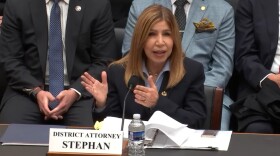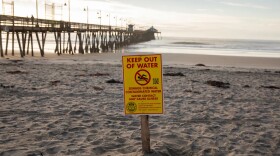MARY LOUISE KELLY, HOST:
Tuesday, August 1, 1944, dearest Kitty - so begins the final entry in Anne Frank's diary. The diary has been in publication since 1947. It details, in her own words, the life of a teenage girl and illustrates the fear and horror endured by Jews during the Holocaust. The diary ends on that summer Tuesday because someone alerted authorities that Anne, her family and four other adults were hiding in the annex of a pectin and spice warehouse in Nazi-occupied Amsterdam.
The identity of the person or persons who betrayed the Frank family has always been a mystery. Now, a new investigation has identified a suspect. Author Rosemary Sullivan chronicles the search in her new book, "The Betrayal Of Anne Frank: A Cold Case Investigation." Welcome.
ROSEMARY SULLIVAN: Thank you.
KELLY: I want to talk through the specifics of what investigators learned. But first, just - how did this cold case investigation come about?
SULLIVAN: It began with a man called Thijs Bayens, who is a filmmaker, and his colleague Pieter van Twisk, who's a journalist. And the two of them in discussion realized that somehow answering this question, which had gone unanswered for 77 years - who betrayed Anne Frank? - would be a route to understanding the horror and failures in Amsterdam at the time of the occupation. And so then they decided to have an outsider lead the investigation and invited the retired FBI special officer Vince Pankoke to come to Holland and lead the investigation.
KELLY: Now, what made Vince Pankoke think that, as you said, 77 years later, he could figure this out?
SULLIVAN: That's an FBI officer's mind, right? He - it was a combination of historical research and artificial intelligence platforms that allowed him to make connections that weren't made before.
KELLY: So walk me through how they did it.
SULLIVAN: Well, Vince went to Amsterdam to live for a year. They went to a data company called Xomnia who created a platform to collect information. They had young historians who collected material from - everything from the CABR files, which are extraordinary files in The Hague that have something like 450,000 dossiers, searching archives throughout the world, putting them in artificial intelligence. They began with 30 scenarios and then were able to come up with about 12 convincing cases of possible suspects.
KELLY: And what was the breakthrough?
SULLIVAN: The breakthrough was, in 1948, there was a police investigation that led nowhere. In 1963, a detective Van Helden did a much more thorough investigation and left behind 120 pages of his - a 120-page report. And in that report, he mentions the existence of an anonymous note Anne's father, Otto Frank, gave him after he returned from Auschwitz, the only survivor of his entire family. And the note said your address was betrayed to the SD by Arnold van den Bergh. Other addresses were also given.
This note, which was proved to be the authentic copy made from Otto Frank's typewriter, had to be tracked down. And from one thing leading to another, it seemed to be clear that the person, Arnold van den Bergh, did give addresses - not names, but addresses of places where Jews were in hiding.
KELLY: Let me focus on the name that you've just given us - Arnold van den Bergh. Who was he?
SULLIVAN: Arnold van den Bergh was a notary in Amsterdam, in the '30s and into the '40s - one of six Jewish notaries in Amsterdam, very respected. He had a passion for art. He collected 17th- and 18th-century Dutch masters, indicating, of course, considerable wealth. And in that process, he became the notary of the famous Goudstikker collection. It meant that he was working with - or an intermediary with Nazis. It doesn't mean that he approved or whatever, but he was in the position of acting as notary when Goering robbed, in effect, by paying so little Goudstikker of his collection.
He had a friend, Miedl, who was a naturalized Dutch banker but of German extraction, who clearly was also an intelligence officer for the Nazis. So he had dealings, as it were, with Nazis, but he was also a complicated man because his children - he gave his children to the resistance to find hiding places for them.
KELLY: Well - and just to just to dwell on that one detail, he was Jewish. I mean, if this is true, if it was him, it would mean Anne Frank and her family were betrayed by a fellow Jew.
SULLIVAN: Yes, but it's not as stark as that. An address was given. The Prinsengracht 263 was given as one of the multiple addresses that were on the list. Arnold van den Bergh was not aware of who would be in hiding at that address. I feel that mitigates it.
But I also feel that to focus on the idea that a Jew betrayed Anne Frank is to miss the point. Arnold van den Bergh was put into an impossible corner. Van den Bergh was like all Jews in Netherlands and elsewhere - under constant threat. How do you keep moral equilibrium in that kind of a context? And his children may have been initially hidden by the resistance, but what kind of protection is that?
KELLY: So for those of us who know, who read Anne Frank's story and who find it so important in telling the story of what happened to Jewish people, what happened during the Holocaust, how does this change her legacy? How does this change how we understand her diaries?
SULLIVAN: I don't think it changes how we understand her diaries at all. Though I think - in one of the opening chapters of the book, I talk about how we read her diaries differently over time. Initially, after the Holocaust and its horrors, people, including the people who made the film of Anne Frank, were looking for consolation. So they quoted her always as saying - shocked that she can still keep her ideals. But in fact, a few pages before, she says that she's also saying human beings are capable of murder. Until this stops around the world, we will always have war.
I think the diary remains as poignant and powerful a document as it's ever been. A child between the ages of 13 to 15, writing with such innocence, such enthusiasm and such terror and fear, and talking about afraid to make noise, afraid to open a window to breathe air - it's such an astonishing document, and it's so immediately powerful.
And there's one thing that struck me as a writer. Anne Frank was saying she wanted to write a mystery story. It would be so good that nobody would know the end until the end. And I'm thinking, I know the end of this story. Three days later, you're in custody, arrested. And a few days later, you're on a transport to Westerbork, the transit camp, and eventually to Bergen-Belsen. That's the story.
KELLY: And it sounds like your argument would be that that girl deserves accountability today, the same as she would have 77 years ago, the same as if this were a story that had unfolded yesterday.
SULLIVAN: Exactly.
KELLY: Rosemary Sullivan - she's the author of "The Betrayal Of Anne Frank." Thank you.
SULLIVAN: Thank you.
(SOUNDBITE OF PABLO NOUVELLE'S "TAMATERT") Transcript provided by NPR, Copyright NPR.







